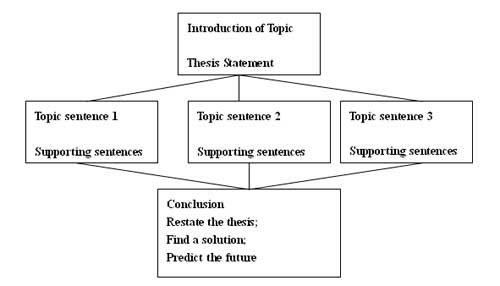自考“英语写作”精讲复习(2)
(三)写作类型——记叙文,描写文
英语写作类型(Types of Writing)主要有四种:记叙文(Narration),描写文(Description),说明文(Exposition)和议论文(Argumentation)。记叙文和描写文在考试中出现的频率很低,几乎不作直接考察,我们只是简单一带而过。记叙文就是讲故事,而且往往是让人在听完或读完故事后有所思考,这就是记叙文的写作目的(可能是隐含的也可能是外显的)。讲故事要先交待清楚故事的语境即时间,地点和人物,然后依据时间顺序展开情节(这里说得是更常见的顺叙,当然还有倒叙,插叙等),讲故事时要注意叙事的角度(第一人称还是第三人称),故事的跌宕起伏(起端,发展,高潮和结局)。
描写文,简单的说就是用语言文字的笔来绘画,画一副人物肖像,画一副地点画,画一副静物画,画一副场景画等。用画笔作画,更重要的是颜色的淡妆浓抹,描写靠的是文字的力量,例如形容词,副词的使用等。但是无论如何画,都要给人留下一个深刻的印象,这一印象就是描写文的写作目的。因此,同学们在写描写文时要围绕着这一印象(中心)来组织写作。
虽然说记叙文和说明文两种文体在英语写作考试中不直接考察,但是它们的作用不容忽视,它们可以被广泛地应用在说明文、议论文的引言段和举例中,能增加说明文和议论文的可读性,趣味性。
(四)写作类型——说明文
说明文(Exposition)是为了解释或阐述某一问题,某一过程或是关系的写作类型。其目的是通过解释,使人明白某件事情,明白如何去做一件事情,或是明白一件事情的原因,及其引发的后果等。
1.总体结构
说明文有比较明确的行文模式,初学者应该对此加以熟悉,才能写好说明文。大致来讲,说明文分为三个部分,五个段落(可适当增加一两个段落)。一个引言段,三个主体段,一个结论段。可参见下图:

2. 引言段 (Introduction)
这一段落的主要目的有两个:引入讨论的话题(topic),并缩小讨论范围,提出论点。因此这一段落更为常见的发展模式就是从一般到具体,从宽泛到合适。通常来讲,我们不直接将观点(thesis)摆出来,而是应该有一些过渡,逐渐的从宽到窄,在引言段的更后提出观点。
a. 引入话题
引入话题的方法和手段很多,例如提供相关背景知识,引用名人名言,名人轶事,善用描写,记叙等手段对某一现象加以描述等。总而言之,引言要简练,自然流畅,能抓住读者的兴趣。大家在阅读范文时要有意识地分析文章的引言段,看作者是如何引入话题的,自己可以仿写。这对写作能力的提高帮助很大。例如下面几个例子。
The other day, I announced that I would go abroad for further studies right after my college education. My decision evoked the immediate objection of my family: Why? Why should I borrow a huge sum of money for overseas studies while I might receive the same education at home at relatively low cost? My answer is: in addition to knowledge, I can gain experiences that those who stay at home will never have.
在这一段落中,作者用个人经历引出主题:海外留学,接着描写家人的反对,和反对的理由。作者使用疑问句,表达了家人的疑问,又为后面作者提出论点做了准备。衔接流畅,一气呵成。
Telecommuting refers to office workers spending much of their time working at home and communicating with their companies through their computers. With the development of computer technologies, it is growing fast and expected to be common for most office workers in the coming decades. The use of telecommuting, however, may trigger major changes to corporate structure, workers' lifestyles and even urban planning.
这一段落中,首先对大家比较陌生的术语telecommuting做了解释,引出远程办公这一主题,然后描写这种办公形式的发展趋势,作者利用however一转,提出自己的观点。
About one of man's frailties Thomas Wolfe wrote, “he talks of the future and he wastes it as it comes.” This observation is related to a principle by which I try (without always succeeding) to live. I believe living in the present because it is futile to dwell on the past, to worry about the future, or to miss anything in the only reality I know.
这一段落中,作者引用Wolfe的名言来引入话题,然后点出自己的论点。
2. 观点/中心思想(Thesis)
观点是说明文的核心,题眼或是灵魂。一篇好的说明文一定要观点明确,简洁明了,具有震撼力。它是一篇文章的总结,它类似于初级写作中段落的主题句,但是它是涵盖全篇的,可能会包含几个主题句。说明文的观点可以直接地表述出来,也可以隐含的表述。但就英语写作学习者来讲,我们提倡明示的观点,而且要对观点进行认真的思考,提炼,要下足功夫。
简单来讲,观点就是作者对某件事情,某种现象的看法,或是对事物要说明的角度等。语法上来讲,一般情况下它是一个陈述句,即 Thesis = Topic + aspects/Opinion.主语往往是主题(Topic),谓语,宾语,状语或是定语往往是作者的观点和说明角度。例如:
主语 - 话题Topic 谓语,宾语 - 观点Opinion
The use of telecommuting, however, may trigger major changes
Price promotions will do damage to a good brand.
Studying overseas had both advantages and disadvantages.
这里说的只是一般形式,在现实中我们还会把我们的观点用各种语言句式表达出来,甚至会很复杂,大大超过了简单的Topic + Opinion形式。例如:These skiers, I discovered, could be divided into distinct categories - for my own entertainment and for the purpose of findings appropriate skiing partners.
好的论点要暗含文章的总体结构。例如In choosing a major, a student has to consider various factors, such as personal interest, job opportunities and the availability of training. 但是万变不离其宗,观点总是中心,而语言表现形式只是外在。因此,在考试解答大纲撰写题,和补齐段落题的阅读阶段,就应该透过复杂的表现形式把握观点的主旨;短文写作时要先确定观点,再推敲确定语言表达形式。
c. 正文部分
说明文正文部分我们一般写三个段落。也就是对观点展开论述。这里涉及到的是段落写作。相信大家在初级写作阶段,已经掌握了段落写作的要领。这里一带而过,段落写作要注意段落的一致性(unity), 发展性(Development)和连贯性(Coherence)。
1) 一致性(unity)
即文章中所有内容都要围绕这文章的中心思想。我们可以具体从两个方面来加以保证。一是,三个段落的内容通过主题句(Topic Sentences)紧扣引言部分的中心思想。如下图:

例如一篇文章
主题是Turning Failure into Success,
中心思想是“Too much emphasis on success is not a good thing.”
主题句1 Certain kinds of success can indeed be destructive.
主题句2. Success that comes too early is also damaging.
主题句3. Success is also bad when it's achieved at the cost of the quality of an experience.
第二,就是每一个段落内容都要围绕自己的主题句思想展开。要做到这一点,作为段落灵魂的主题句(Topic Sentence)一般放在段落的开始较好,后面是若干支持句。

例如:
主题句:These days lifestyles seem to change fast.
支持句1. It is more than just clothing and hairstyle that are in style one year and out or date the next; it's a whole way of living.
支持句2. One year people wear sunglasses on top of their heads and wear jeans and boots; they drink white wine and eat sushi at Japanese restaurants; for exercise they jog several miles a day.
支持句3. However, the next year they notice that everything has changed.
支持句4. Women wear long skirts; people drink expensive water from France and eat pasta at Italian restaurants; everyone seems to be exercising at health clubs.
2) 发展性(Development)
就是要充分发展段落主题思想。通过不同的角度,用想尽的事实例证来说明。有了主题句,要把一个段落写好,称为well-developed paragraph, 需要了解一些常用的段落发展技巧办法。
举例法(Exemplification)
Americans generally like a lot of physical space in their organizational lives. Many American clichés point to this: “Give me some space,” “Get out of my face,” “Back off.” Hand shakes last only a second or so. If two passengers remain after a crowded elevator has emptied, they immediately take chance like steps to their respective corners.
数据法(Statistics)
English becomes the most taught language in the world. Two hundred and fifty million Chinese- more than the entire population of the United States- study English in eighty-nine countries, English is either a common second language or widely studied. In France, state-run secondary schools require students to study four years of English or German, most- at least 85 percent- choose English. In Japan, secondary students are required to take six years of English before graduation.
对比分析(Contrast)
Unfortunately, doing things badly has gone out of style. It used to be a mark of class if a lady or a gentleman sang a little, painted a little, played the violin a little. You didn't have to be good at it; the point was to be fortunate enough to have the leisure time for such pursuits. But in today's competitive world we have to be “experts” even in our hobbies.
类比法(Analogy)
A western-style conversation between two people is like a game of tennis. If I introduce a topic, a conversational ball, I expect you to hit it back. If you agree with me, I don't expect you simply to agree and do nothing more. I expect you to add something - a reason for agreeing, another example, or a remark to carry the idea further. But I don't expect you always to agree. I am just as happy if you question me, or challenge me, or completely disagree with me. Whether you agree or disagree, your response will return the ball to me.
权威法(Authoritative statements)
Timing is another factor. “If you took George Washington and put him in 20th century he would go nowhere as a politician,” declared Deam Leoth Simonton, a professor of psychology at the university of California, “he was not an effective public speaker, and he didn't like shaking hands with the public. On the other hand, I am not sure Franklin Roosevelt would have done well in Washington's time.”
3) 连贯性(Coherence)
是英语写作中很重要的一个原则。它是指文章中的句子之间,段落之间彼此相互关联,衔接自然。句子间的连接主要是靠连接词来完成。(重要连接词参见附录。)
过渡词表示逻辑意义可以分为一下几类:
A. 表举例的
For example, for instance, as a case in point, in the case of, as a illustration, such as, like, that is, say.
B. 表示比较的
Similarly, likewise, in the same manner, the same … as, like, both, equally important
C. 表示对照的
On the contrary, on the other hand, by contrast, unlike, whereas, rather than, conversely, instead, the opposite is true.
D. 表示让步的
Although, though, nevertheless, however, but, yet, admittedly, it is true… but, in spite of, even though.
E. 表示原因的
Because, as, since, for, owing to, due to, as a result of, on account of
F. 表示结果的
Thus, so, hence, consequently, therefore, accordingly, for this reason, as a consequence
G. 表示强调的
Chiefly, especially, indeed, in fact, certainly, particularly, to be sure, actually, above all, most important, worse, as a matter of fact, no doubt
H. 表示梯进的
First, second, in the first place, in the second place, next, also, besides, furthermore, moreover, in addition, what is more, for one thing, not only… but also.
I. 表示时间的
Earlier, previous, formerly, before, after, as, until, meanwhile, latter, afterwards, next.
J. 表示结论的
In conclusion, in short, on the whole, finally, lastly, to sum up, to conclude, in any event.
K. 表示空间的
Above, across, beyond, in front of, next to, opposite, under, below, nearby, close to
d. 结论
说明文的结论往往是对观点和中心思想进行重新的叙述,总结全文,提出某一问题的解决方案,或是对某一事件进行预测,提出警示,得到的启发等。但是结论切忌在引出新话题,要简洁自然。












